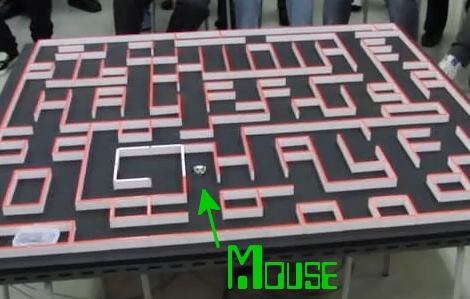
Looking for something to build that will be challenging and interesting to laypersons at the same time? Take some inspiration from this maze-solving robot mouse. It take the idea of a line-following robot, and makes it infinitely more cool. The tiny rover uses sensors to map out a physical maze. Once it figure it out, you put it back at the beginning for a speed run to the finish. We’ve embedded the video below showing the whole process. Looks like the speed-run is completed in just under five seconds.
Now that you’ve enjoyed a virtual mouse in a real maze, check out a real mouse in a virtual maze.
[youtube=http://www.youtube.com/watch?v=FzBwnsnxFGU]
[Thanks Bemental]
















I’d like to see some more specs on that mousie. Like what type of sensors it uses, how it handles slip etc during its SLAM process (it almost has to be using Simultaneous Localization and Mapping to be able to build a map to solve the maze faster).
This just made my day!
‘Once it figure it out’
@Dex They’re climbin in your windows, they’re snatching your people up.
Yes this made as much sense as your post.
Amazing computational ability in such a little package. Ahh makes me sad i can only build something 7 times as large, uses 4 times more power, wheighs 10 times as much and has 1/10 of the quality *sniff*.
Psshh. Claude Shannon did this like 60 years ago:
http://techchannel.att.com/play-video.cfm/2010/3/16/In-Their-Own-Words-Claude-Shannon-Demonstrates-Machine-Learning
Guide to making a Japanese robot:
1. Take something small and make it smaller.
2. Give it an animal shape OR name it after an animal.
3. Add the most obnoxiously-cute beep sounds and tones.
4. Make a YouTube video of it.
Tom, you beat me to it.
There used to be actual contests for IRL robot “mice” to solve actual physical mazes 20-30 years back (the “mice” were sometimes almost R2D2-sized). Whatever happened to those contests?
I want one. . .
We had a similar course in my Uni, Interactive Media Dedesign. Basically the students were taught how to use the ARDUINO and blink LEDs and such.
Not to mention that they all looked like the kind of people that would write their novel on their macbook at Starbucks.
Interesting that it has no spatial awareness what-so-ever. A simple “spin out” and it’s completely lost – even though it’s in a area it’s completely mapped out before
The maze almost spells HACK.
A traditional maze can be solved by constantly hugging the right-hand wall. If there’s an intersection, follow the right wall (by turning right). You will always reach the exit.
We used to do micromouse competitions many years ago at university. Very challenging! But it is also fun to do.
Looks like it just uses some variant of the left-hand rule. Not very efficient. Can it be adapted to use other solving algorithms?
@AJ Robins: Here you go: .
My uni team is competing in this event next April at RoboGames. We’re wrapping up the planning stage and will start building soon. I hope to document the process and maybe submit it here if there’s any interest.
Whoops, re-do on that link: http://robogames.net/rules/maze.php
It is easy to make a maze which can’t be solved by just hugging the left or right wall, so no the method is more complex than that.